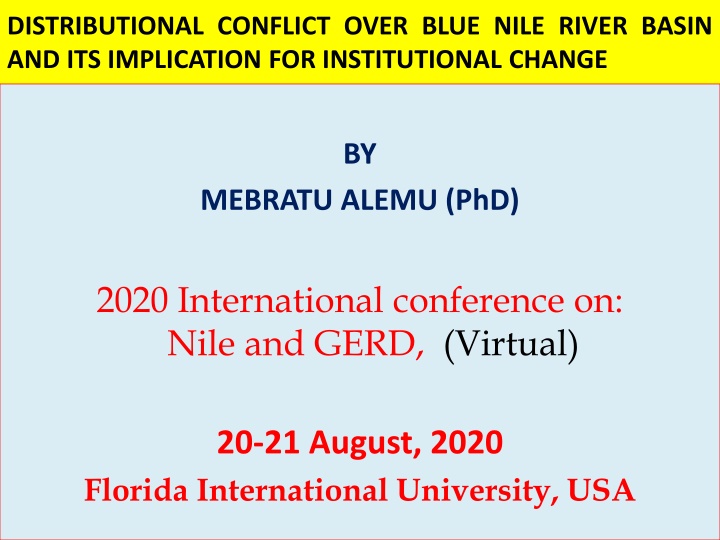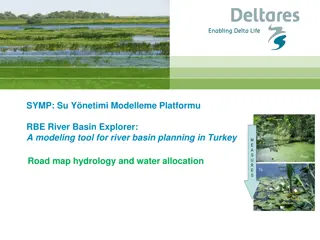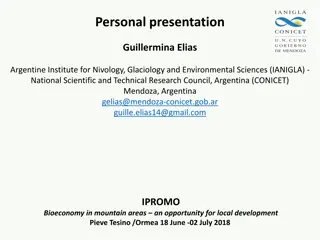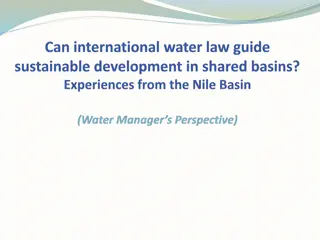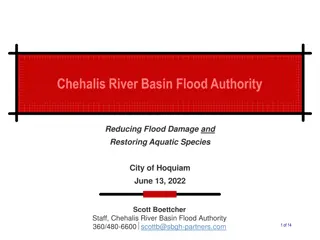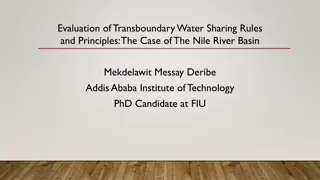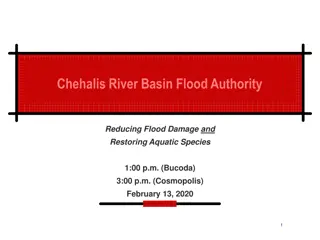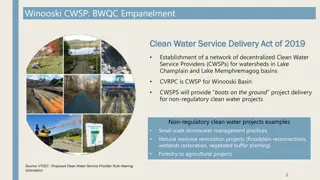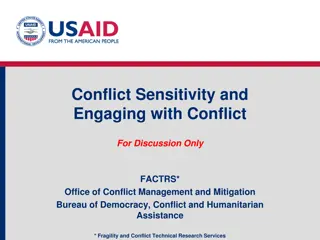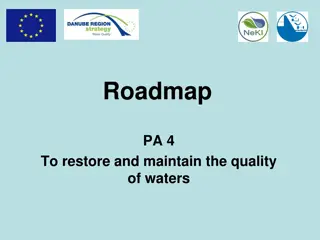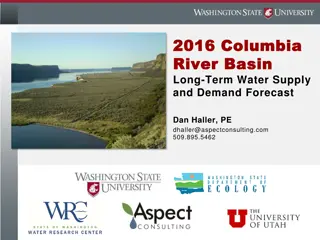Distributional Conflict over Blue Nile River Basin and Its Implication for Institutional Change
The study by Mebratu Alemu explores the distributional conflict among riparian countries over the Blue Nile River Basin, highlighting the challenges and implications for institutional change. Through analyzing property rights changes and investigating drivers behind conflicts and cooperation, the research aims to shed light on the complex dynamics surrounding water distribution issues in the region.
Uploaded on Nov 24, 2024 | 7 Views
Download Presentation

Please find below an Image/Link to download the presentation.
The content on the website is provided AS IS for your information and personal use only. It may not be sold, licensed, or shared on other websites without obtaining consent from the author.If you encounter any issues during the download, it is possible that the publisher has removed the file from their server.
You are allowed to download the files provided on this website for personal or commercial use, subject to the condition that they are used lawfully. All files are the property of their respective owners.
The content on the website is provided AS IS for your information and personal use only. It may not be sold, licensed, or shared on other websites without obtaining consent from the author.
E N D
Presentation Transcript
DISTRIBUTIONAL CONFLICT OVER BLUE NILE RIVER BASIN AND ITS IMPLICATION FOR INSTITUTIONAL CHANGE BY MEBRATU ALEMU (PhD) 2020 International conference on: Nile and GERD, (Virtual) 20-21 August, 2020 Florida International University, USA
CONTENTS OF PRESENTATION INTRODUCTION OJECTIVES OF THE STUDY THEROTHICAL AND CONCEPTUAL FRAMEWORK RESULTS AND DISCUSSION CONCLUSION AND RECOMMENDATIONS
INTRODUCTION The Nile is one of the world s longest rivers, passing through 6,695 km. The drainage Basin of the Nile covers about 3.2 million square kms spread. The basin area is about 1/10 of the land area of Africa & is shared by 11 countries.
INTROD..CONTD.. The Basin has significant potential for: Clean energy (hydropower) dev t & power trade; Irrigated & rain-fed agri. prodn; Preservation & use for eco-tourism Drinking water, navigation, recreation maintenance.. fisheries & prodn, ecosystem
INTROD..CONTD In spite of all the importance Basin(BNB), the scientific understanding of the Nile has been limited due to: Insufficient basin-wide hydrologic, meteorological, climatic, socio-economic, ecosystem related data & info, & institutional capabilities. Asymmetry among the riparian countries in terms of water infrastructure dev t, institutional & technical capacity. These challenges & threats are by their very nature trans-boundary & the impact that the river has had on the international politics of the region is evident. of the Blue Nile
Objective of the study The General Objective Is to examine the distributional conflict & its implication for institutional change among the 3 riparian countries over Blue Nile River. The Specific Objectives To analyze the property rights change about the utilization of Blue Nile River Basin over time. To investigate the driving forces behind conflicts & cooperation regarding issues of water distrib. among 3 countries.
1.3. Theoretical and Conceptual Framework Contemporary theoretical debates on PR change are competing schools. Each side identifies d/nt factors as critically responsible for the change of PR. dominated by 2
THEORY..CONTD.. The economic school The distributional school regards potential collective efficiency gains as the key factor pushing change. view PR evolution response to relative prices, opening of new markets, popn change, technological innovation. emphasizing the demand side of institutional change (i.e., gains from the change). stresses distrib. Inequality as the determinant force for the evolution of PR. Potential improv t cannot be materialized when distr. inequality is involved. Distrib. conflicts inherent in any PR arrangement, can block or critically institutions adopted (Libcap, 1998). for PR in PR as a changes via of the constrain that the be can
THEORY..CONTD.. Distributional school(contd..) Some get better off(winners); others worse off(losers) b/c of PR change. The losers are expected to take measures to block PR change if such measures are not so costly to them as the PR change. factors such inequality on the supply side can block PR change. stresses that distrib. disadva. created by PR change may induce potential losers to take efforts to impede it (Libecap , 1989). However, it is equally likely that distrb. advantage may induce winners to take steps to speed up & facilitate the change of PR. stresses the role of winners: the main goal of those who develop institutional rules is to gain strategic advantage vis- -vis other actors (Knight ,1992). as distrib.
Conceptual..contd.. How social, economic, legal, & political factors exert their influence on the formation of new equilibrium that shed light on the complicated process of restructuring PR over fair utilization of Blue Nile River. Focus on how economic actors come to grips with their sometimes conflicting & sometimes converging interests in constructing new PR over utilization of the common river.
2. METHODOLOGY OF THE STUDY 2.1. Data sources and Method of Collection Secondary data sources from d/nt concerned bodies & agencies were gathered. Published & unpublished documents like statistical figures, news papers, media and reports related to the subject matter from FAO, World Bank, Ministry of water resources were critically reviewed. 2.2. Data Analysis and Presentation In order to analyze the past and the current institutional interactions of actors (Ethiopia, Egypt and Sudan) about Blue Nile water sharing & see if any PR change exists over utilization of the common river, the Institutional Analysis Development Framework shown before was used.
Population and water withdrawal of the 3 countries Country Popon. 2015 E (000s) Total H20 withdrawal Total water withdrawal per capita per year Water withdrawal in (m^3/year) Agriculture Municipality Industry Ethiopia Year % age 99,391 (2015 E) 5.2 *10^9 (2002 E) 93.63 % 0.05*10^9 (2005 E) 5.99 % 0.81*10^ 9 (2005 E) 0.37 % 5.558*10^9 (2002 E) 78.96 m^3/yr Egypt Year %age 91,508 (2015 E) 67*10^9 (2010 E) 86 % 9*10^9 (2010 E) 11.54 % 2*10^9 (2000 E) 2.6 % 78*10^9 (2010 E) 910.6 m^3/yr Sudan Year %age 40,235 (2015 E) 25.9*10^9 (2011 E) 96.2 % 0.075*10^9 (2011 E) 3.5 % 0.995*10 ^9 (2011 E) 0.28 % 26.94*10^9 (2011 E) 714.1 m^3/yr Source: (FAOSTAT, 2015).
Result..contd Agreed and conflicting issues over utilization of Nile River(PR change Institutional change ) Pre Colonial Agreements Colonial Agreements Post colonial Agreements The Blue Nile basin features significant conflict over access and rights to the Nile water resources among the 3 riparian countries(ETHIOPIA, SUDAN & EGYPT) Most of the existing agreements were reached between the colonial powers, or b/n Egypt & the colonial powers.
Year Parties Agreed Issues Conflicting Issues of Ethiopia Egyptian Pasha to cut off the Nile. King threatens Ethiopia and Egypt 1704 Agreement was signed to limit Ethiopian intervention with the Nile waters. Nile Water Treaty: Britain provided Egypt with the monopoly over the river, allocating only 4 billion cubic meters to Sudan. Nile Water Treaty signed when pro-Egyptian government elected in Sudan. Water Agreement on the full utilization of the Nile water. Britain and Ethiopia 1902 48 BCM- Egypt 4 BCM-Sudan Britain and (newly Nile independent) Egypt 1929 55.5 BCM-EGYPT 18.5 BCM-SUDAN 10 BCM-LOST --EVAPORATION Egypt and Sudan 1959 Egypt and Ethiopia Ethiopia s proposed construction of dams on the headwaters of the Blue 1978 Anwar Sadat declared: The only matter that could take Egypt to war again is water Egypt and Ethiopia 1979
Parties Agreed Issues Conflicting Issues Year 1992 The Technical Cooperation Committee for the Promotion of the Dev t & Env tal Protection of the basin (TECCONILE) was established. 1994 Egypt & Sudan Egypt planned and then cancelled an air raid on Khartoum, where a dam was being built. Increased tensions over the attempted assassination of President Mubarak. To achieve sustainable socio-economic dev t through the equitable utilization of, & benefit from, the common NB water resources. 1995 Egypt & Sudan 1999Water ministers of nine countries established NBI 2001Egypt, Sudan, & Ethiopia established the Eastern Nile Subsidiary Action Plan (ENSAP), coordinating their efforts to execute joint & independent irrigation, hydroelectric power, & water mgt projects in the basin. 2010 6 upstream (NBI) members signed the Cooperative Framework Agreement (CFA), 4 members ratified the Entebbe Agreement:to establish principles, rights and obligations to ensure long-term & sustainable mgmt and dev t of the shared Nile waters. Ethiopia has launched the construction of the Grand Ethiopian Renaissance Dam, GERD. 6,000MW, create a lake with a volume of about 74 billion cubic meters 2011 2015 Signed "Declaration of Principles to put an end to a four-year dispute over Nile water sharing arrangements among Nile Basin countries Egypt, Ethiopia & Sudan
Result..contd The 4th principle of the March 2015 declaration i.e. the Principle of fair and appropriate use ,the 3 countries agreed to use their common water sources in their provinces in a fair & appropriate manner. The 9th principle of declaration i.e. the principle of the sovereignty, unity and territorial integrity of the State The 3 countries agreed to cooperate on the basis of equal sovereignty, unity & territorial integrity of the state, mutual benefit & good will, in order to better use & protect the River Nile. This could be considered a big progress for PR change over the use of Blue Nile River.
Two contrasting views Future cooperation Future conflict views water resources as an arena for future conflict. (J. star, 1991; Fakenmark, 1992; Gelak, 1993; Jorgakos, undated) views water resources as an arena for future cooperation (Arsano, 2007; Elise Bolding, 1993) No state boundary, no barbed wire, no wall can stop water flowing along its natural course.
Results continued Verbal conflicts B/n Ethiopia and Egypt Egypt is the gift of the Nile. Herodutus in 5th Century B.C.E Without Nile, there would have been no food, no people, no state, & no monuments in Egypt and Sudan Boutros Boutros-Ghali (1988), the former secretary- general of the UN, has predicted that the next war in the region will be over water BBC(2000) indicated that In the next 25 years water scarcity will be the main source of conflict .
Contd In 2000, the American congress also indicated water distrib. conflict will be the major factor that would threaten Sub-Saharan African countries especially EGYPT, SUDAN & ETHIOPIA. Former Egyptian president Morsi warned that if Egypt s share of the Nile s water diminishes by one drop, that blood would be the alternative Ethiopian PM Meles Zenawi told Algezira: While Egypt is taking the Nile water to transform the Sahara Desert into something green, we in Ethiopia who are the source of 86% of that water are denied the possibility of using it to feed ourselves.
Contd To the contrary, shared waters can better serve as catalyst for cooperation rather than conflict(Arsano, 2007). Arsano does not see any risk of "water wars" within and b/n states in the Nile Basin. Yet, the riparian countries still did not established a confidence and trust in one or another way to fully cooperate.
Future Pressures on the Niles Water Flow Survival resource scarcity Increased H20 scarcity popn growth Interstate tension and conflict over water sharing Land degradation & loss of biodiversity Scarce arable land Electricity demand Livelihood insecurity Human interference in H20 SS Land use change Need for changed water distribution
CONCLUSIONS AND RECOMMENDATION There is no integrated plan for optimum use & dev t of the waters of this river, which could benefit the 3 countries. This study believes that In order to satisfy the future water demands of the economy & the popn growth, utilization of our common resource i.e Blue Nile River will be intensified and hence; One could expect that future conflicts over water sharing are highly probable. Moreover, we have to make sure that new rules of PRs over the fair & equitable use of Blue Nile River will serve the interests of those with strong bargaining power. AS Libecap claimed distributional inequality can impede PR change also sheds light on the role of distrib. inequality in PRs transformation over the fair use of Blue Nile River among the 3 countries.
Conclu and recomm..contd Since water crisis in the Blue Nile River Basin is predictable; Strengthening regional integration & the credible commitment in order to promote mutually beneficial inter-dependencies is very crucial. This study suggests that Ethiopia should exert maximum effort in convincing countries to ratify the Entebbe Agreement (CFA) b/c any continued delays in negotiations will lead to further degradation of relations between the 3 states.
